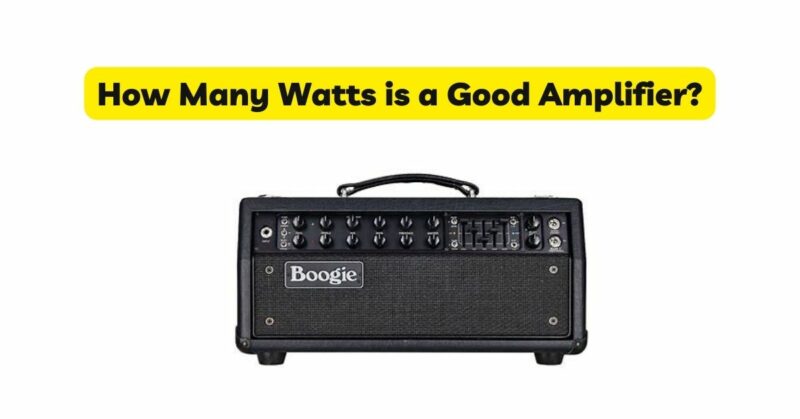Choosing the right amplifier is crucial for achieving the desired sound quality and volume in any audio setup. One of the primary considerations when selecting an amplifier is its power output, typically measured in watts. However, determining the ideal wattage for an amplifier can be a complex task, as it depends on several factors such as application, venue size, speaker efficiency, and personal preferences. In this article, we will explore the various considerations involved in determining the appropriate wattage for different audio setups and provide guidelines to help you make an informed decision.
Understanding Amplifier Power
Amplifier power refers to the electrical energy a device can deliver to the speakers or headphones. The power output is usually stated in watts, and it directly influences the volume and dynamics of the sound produced. Higher wattages generally result in louder volumes and better headroom, allowing for cleaner and undistorted sound reproduction. However, it is important to note that wattage alone does not determine the quality of sound. Factors like the amplifier’s design, circuitry, and overall build quality also contribute to the audio performance. Therefore, it is essential to consider wattage in conjunction with other specifications and features when selecting an amplifier.
Home Audio Systems
For home audio systems, the power requirements vary depending on the room size, speaker sensitivity, and personal listening preferences. In general, most home audio setups can be adequately powered by amplifiers with wattages ranging from 20 to 100 watts per channel. This range provides sufficient power for casual listening and small to medium-sized rooms. If you have larger rooms or enjoy listening at higher volumes, you may opt for amplifiers with higher wattages, such as 100 to 200 watts per channel. This extra power ensures that the amplifier can drive the speakers with ease, maintain clarity, and handle dynamic peaks without distortion.
Live Sound and Performance
In live sound applications, the wattage requirements depend on the venue size, the intended volume level, and the genre of music being performed. Small venues, such as coffeehouses or intimate clubs, can typically be adequately served by amplifiers ranging from 50 to 200 watts. These amplifiers provide enough power to fill the space and project the sound without overwhelming the audience. Medium-sized venues, such as theaters or mid-sized concert halls, may require amplifiers with wattages ranging from 200 to 500 watts per channel. This additional power ensures that the sound reaches every corner of the venue, maintains clarity, and can handle the dynamic range of live performances. For large venues, outdoor festivals, or stadium-sized events, more powerful amplifiers in the range of 500 to 2000 watts or more may be necessary. These high-power amplifiers ensure that the sound can cut through the ambient noise, provide sufficient headroom for dynamic performances, and deliver the necessary impact to a massive audience.
Studio Recording and Mixing
In studio environments, the power requirements are often more modest compared to live sound applications. The focus is on accuracy, transparency, and detailed monitoring rather than sheer volume. In most cases, amplifiers with wattages ranging from 5 to 50 watts per channel are sufficient for driving near-field studio monitors and headphones. Since studio monitoring is typically done at close range, excessive wattage is not necessary and may even introduce unwanted coloration or distortion. It is more important to prioritize amplifier quality, low noise levels, and accurate frequency response when selecting amplifiers for studio applications.
Speaker Efficiency and Sensitivity
Another critical aspect to consider when determining amplifier wattage is the efficiency and sensitivity of the speakers. Speaker efficiency is measured in decibels (dB) and indicates how much sound pressure level (SPL) the speaker can produce with a given amount of power. Speakers with higher efficiency ratings require less power to achieve a certain volume level, while less efficient speakers may require more power to produce the same output. When pairing amplifiers and speakers, it is essential to ensure compatibility between their power ratings. An amplifier should have sufficient power to drive the speakers without being underpowered or overdriven. Matching the amplifier’s wattage to the speaker’s power handling capability ensures optimal performance, longevity, and protection against potential damage.
Conclusion
Determining the ideal wattage for an amplifier depends on various factors such as application, venue size, speaker efficiency, and personal preferences. For home audio systems, wattages ranging from 20 to 100 watts per channel are generally sufficient, but higher wattages may be preferred for larger rooms and higher volume levels. In live sound applications, the wattage requirements increase with venue size, ranging from 50 to 200 watts for smaller venues, 200 to 500 watts for medium-sized venues, and 500 watts or more for large venues and outdoor events. Studio applications prioritize accuracy and transparency, with wattages ranging from 5 to 50 watts per channel, depending on the monitoring setup and speaker sensitivity. Remember that wattage alone does not determine the overall sound quality, and it is important to consider amplifier design, circuitry, and other features when making a decision. By understanding your specific needs, considering venue requirements, and ensuring compatibility with speakers, you can select an amplifier with the appropriate wattage to achieve the desired audio performance.

